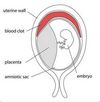Week 1 Flashcards
(132 cards)
3 bones that fuse together to form the “innominate bones” of the pelvis
Ilium
Ischium
Pubis
Of the three fused bones that make up the innominate bones of the pelvis, which differs the most between the sexes?
Pubis

What vertebral level is the PSIS?
S2
What is the bony attachment site for all the hamstring muscles?
What is the bony attachment site for the external genitalia?
Ischial tuberosity
Ischiopubic ramus

What nerve runs through the obturator foramen?
What bony processes form the boundaries of the obturatory foramen?
The obturator nerve runs through the obturator foramen
Superiorly - superior pubic ramus
Inferiorly - ischiopubic ramus
What kind of joint is the pubic symphisis?
Secondary cartilaginous
What bony landmark is palpable on vaginal examination?
The ischial spines

What are the attachments of…
- the sacrospinous ligament
- the sacrotuberous ligament?
What nerve runs between these two ligaments?
Sacrospinous ligament - sacrum and ischial spine
Sacrotuberous ligament - sacrum and ischial tuberosity
The pudendal nerve runs between these two ligaments, curves around the sacrospinous ligament
What ligament separates the greater and lesser sciatic foramina?
The sacrospinous ligament (and also the sacrotuberous ligament…)
What are the borders of the pelvic inlet?
What are the borders of the pelvic outlet?
Which is more superior?
Pelvic inlet
- sacral promontory
- ilium
- superior pubic ramus
- pubic symphysis
Pelvic outlet
- pubic symphysis
- ischiopubis ramus
- ischial tuberosities
- sacrotuberous ligaments
- coccyx
The pelvic inlet is more superior

What muscle is also known as the “pelvic floor” muscle?
What is the space between the pelvic floor and pelvic inlet called?
Levator ani
The space is called the pelvic cavity and contains the pelvic organs and supporting tissues
How does the pelvic anatomy of the female differ to that of the male?
AP and transverse diameters of the pelvis are larger in the female, both at the pelvic inlet and outlet
The suprapubic angle is greater in the female
The pelvic cavity is shallower in the female
What is the term given to the movement of one bone over the other that allows the foetal head to change shape during delivery?
Moulding
What could the following indicate…
- bulging fontanelles
- depressed fontanelles?
Bulging - increased fluid/ICP
Depressed - dehydration
Which of the two diameters of the foetal head is bigger?
What is the name of the diamond shape made between the two greatest points of the biparietal diameter (parietal eminences) and the anterior and posterior fontanelles?
The Occipitofrontal diameter is greater than the Biparietal diameter
The vertex is the diamond bordered by the two fontanelles and the biparietal eminences
What is the distance of the foetal head from the ischial spines referred to?
What position is the baby’s head initially in when entering the pelvic cavity? Why is this the case?
Station (negative number means the head is superior to the spines, positive number means the head is inferior)
The baby’s head is ideally facing left or right. This is because the transverse diameter of the pelvic inlet is greater than the AP diameter, while the OP diameter of the foetal head is greater than the biparietal diameter.
Why does the baby’s head change from being faced left-to-right to an occipitoanterior position (OA), ideally, during delivery?
Should the baby’s head be in extension or flexion at delivery?
While at the pelvic inlet, the transverse diameter is greatest, hence left-to-right
At the pelvic outlet, the AP diameter is greater, so the baby’s head needs to rotate, ideally being in the occipitoanterior position i.e. the baby’s occiput and the mother’s anterior
When descending through the pelvis, the baby’s head should be in a flexed position (chin to chest), and when delivered should be in an extended position
When delivering a baby, which shoulder is delivered first?
Once head is delivered, the baby must rotate again in order to pass the shoulders
First the top shoulder (mother’s anterior) is delivered, then the bottom shoulder
What is the name of the dense outer shell of connective tissue that surrounds the cortex of the ovary?
What is it covered by?
Dense outer shell - tunica albuginea
Covered by a single layer of cuboidal cells called the germinal epithelium

Regarding the structure of the ovary, what are the two main areas of tissue and what do they contain?
Cortex - contains ovarian follicles in a highly cellular connective tissue stroma
Medulla - core of the organ, contains neurovascular structures

During embryonic development, at roughly what point do germ cells from the yolk sac invade and proliferate?
What do they form when they do this?
Approx week 6
Germ cells invade and proliferate via mitosis to form immature reproductive cells (oogonia). These cells will undergo further development and division via meiosis to form mature oocytes
What is the name of layer of cuboidal granulosa cells present that defines the primary follicle?
What is the name of the layer of specialised ECM that begins to form between the oocyte and these granulosa cells?
Layer of cuboidal granulosa cells - zona granulosa
Layer of specialised ECM - zona pellucida
In the late primary follicle, what do inner layers of stromal cells form and what do they then secrete?
The inner layers of stromal cells transform into the theca interna, which then secretes oestrogen precursors - these will then be converted to oestrogen by granulosa cells

The development of what structure within the granulosa layer defines a follicle as being secondary, rather than primary?
Development of the antrum - space filled with follicular fluid within the granulosa layer












